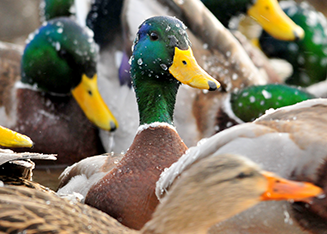Our DR Trip
Multi-regional Collaboration with the Dominican Republic
 Part 1 : Our Migratory Birds in the Dominican Republic
Part 1 : Our Migratory Birds in the Dominican Republic
A delegation of biologists from the FWS Division of Migratory Birds recently traveled to the Dominican Republic to meet with stakeholders and managers of important wintering habitat for several migratory birds, including extremely vulnerable species such as Bicknell’s Thrush. Bicknell’s Thrush is among the landbirds of highest conservation concern in North America because of its small population size, geographically restricted breeding and wintering distribution and habitat preferences, declining population, and severity of ongoing and forecasted threats. The great majority of Bicknell’s Thrush winter in the Dominican Republic.
Part 2 : Bicknell’s Thrush Conservation in the Sierra de Bahoruco
The island of Hispaniola supports about 80% of the Bicknell’s Thrush population during the wintering period (November to April). The Sierra de Bahoruco represents the primary wintering location of Bicknell’s Thrush. Sierra de Bahoruco National Park in the Dominican Republic, a core area within one of the United Nations Educational, Scientific and Cultural Organization’s Biosphere Reserves, is one of the two most significant wintering areas for Bicknell's Thrush. Sierra de Bahoruco National Park supports some of the largest tracts of its high-elevation cloud forest habitat in Hispaniola and may be the most biodiverse areas in the Caribbean.
Part 3: Challenges and opportunities for collaboration across borders
Recent but unofficial evidence indicates that an ecological crisis is underway within Bahoruco forests. Since about 2009, satellite images and anecdotal reports have indicated that, trees inside the national park, and particularly the key Thrush habitat, the cloud forest, is being cut at an unchecked pace. Anecdotal reports indicated that the cutting was primarily for commercial charcoal production and commercial avocado plantations, but also for subsistence farming by sharecroppers. The conservation issues here are intertwined with complex social and economic issues, including immigration from Haiti, exceptionally high poverty rates in this area of the country, lack of clarity about land ownership, insufficient enforcement of laws, allegations of corruption, and unchecked commercial exploitation.
The delegation traveled to explore potential opportunities for the Service to work with the Dominican Republic in identifying and implementing actions to help address our mutual interests. The delegation met with government officials from the Ministry of the Environment, representatives from nongovernmental organizations, other government agencies, and local communities bordering the park and visited the affected areas. These conversations laid the groundwork for further collaboration between USFWS and the Dominican Republic government and NGOs to address the issues affecting our shared migratory birds.
US Fish and Wildlife Service (USFWS) Neotropical Migratory Bird Conservation Act (NMBCA) has funded projects in the Bahoruco region to try to improve management of protected areas by aiding park guards with support, adding signage, promoting ecotourism, reforesting and undertaking other conservation actions. NMBCA grantees, match partners or subgrantees have included: American Bird Conservancy, BirdsCaribbean, Vermont Center for Ecostudies, Bridges to Community, Sociedad Ornitológica de La Hispaniola (Hispaniolan Ornithological Society), and Grupo Jaragua, as well as the Dominican Ministry of the Environment.


